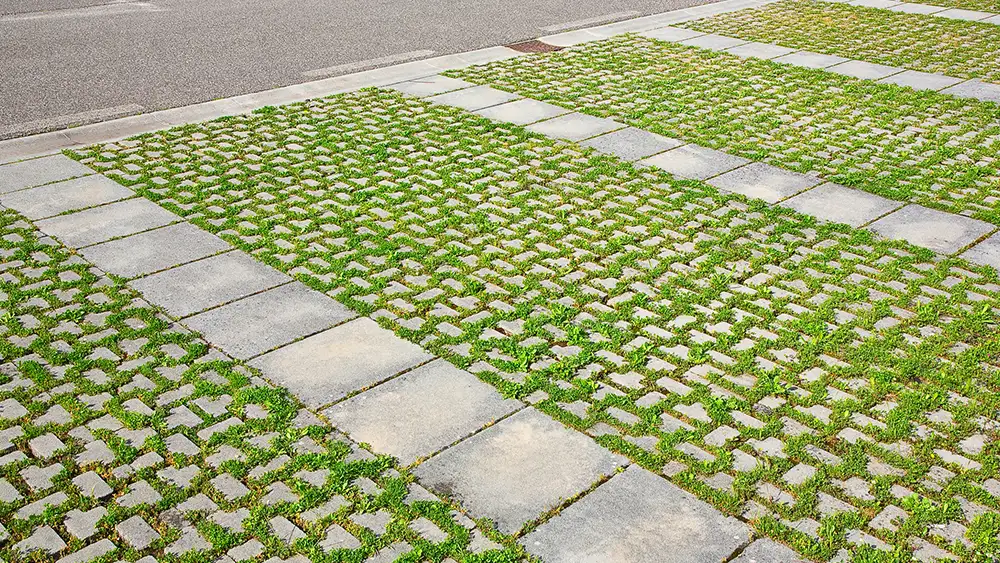In the ever-increasing quest for sustainable pavements versus functional and cost-efficient pavements, permeable pavements have become the go-to solution. They’re touted as an excellent solution to manage water runoff, avoid the heat island effect, and filter out pollution. Are permeable pavements the best alternative to traditional concrete and asphalt solutions, and are they worth the extra cost to the customer?
What Are Permeable Pavements?
Porous Asphalt
Porous asphalt consists of a stone aggregate base and an asphalt binder. Its open structure enables water to drain through, reducing surface water runoff. However, like traditional asphalt, regular maintenance is required to prevent clogging and maintain its permeability.
Permeable Concrete
Permeable concrete, also known as pervious or porous concrete, is made with a combination of cement, coarse aggregate, and water. By reducing the amount of fine particles, permeable concrete creates a network of interconnected voids that allow water to infiltrate. This type of pavement provides excellent stormwater management, reduces the heat island effect, and can even help recharge groundwater. It also requires periodic maintenance to prevent sediment buildup, which can clog the pavement and allow water to sit on top instead of draining properly.
Permeable Pavers
Permeable pavers are made of concrete or plastic. The pavers are interlocking and allow space between them, which creates spaces between them and allows water infiltration. Their design is flexible and can give the client some creative leeway and allow for vegetation if desired. Pavers are initially more expensive than typical pavement, but they are easy to maintain, durable, and, of course, offer sustainability.
Grid Systems
Grid systems consist of interlocking plastic or concrete grids that create a stable surface while allowing water to seep through. These systems provide excellent load-bearing capacity, making them suitable for heavy traffic areas like parking lots. Grid systems are well-suited for retrofitting existing pavements, promoting drainage, and supporting healthy root growth in grassy areas. Periodic maintenance is essential to remove debris that can accumulate and impede water infiltration and foot traffic.
How Is Permeable Pavement Constructed?
Permeable pavements function because of the increased permeability of the top layer of pavement and the reservoir beneath it to catch water and slowly filter it back into groundwater. Permeable pavement consists of four layers:
Pavement Layer – The top pavement layer consists of coarse aggregate and varies in thickness from two to four inches, depending on the site’s structural needs. This layer accommodates a 16% void volume, four times that of a traditional mix.
Top Filter – Beneath the pavement is a layer of crushed stone, usually with a depth between half an inch to two inches. This layer serves as a base for the pavement while allowing water to pass through to the reservoir.
Reservoir – This layer is typically two to four feet of gravel, depending on the required storage volume for the area. The reservoir has up to a 40% void volume.
Bottom Filter – This final layer usually contains a filter fabric over the soil and a layer of sand as a final base.
What Are The Pros and Cons of Installing Permeable Pavements?
The biggest pro when using permeable pavements is the ability to manage larger volumes of water from storm runoffs. Of course, an added benefit is that it allows the water to filter back into the ground and replenish the groundwater. In many areas of the United States, groundwater is becoming depleted, mainly from overuse of pumping water to the service for both agricultural and human consumption. Groundwater supplies drinking water to half the population in the U.S., and nearly all rural populations rely on it.
Other pros to installing permeable pavement:
- It reduces the heat island effect in large urban areas.
- Allows greater room for tree roots to spread, which can be helpful in zones where trees are protected or desired for landscaping.
- Research indicates that permeable pavement allows water to infiltrate even in cold climates. Additionally, it freezes slower and thaws quicker than traditional pavement, reducing the need for deicer.
- It filters out pollutants from the groundwater system.
- Negates the need to build above ground water retainment systems.
- Suitable for driveways, walkways, parking lots, and many low to medium-traffic areas.
Of course, permeable pavements also have their drawbacks. The biggest drawback is that permeable pavement is susceptible to clogging. For optimal performance, it’s recommended to use a vacuum sweeper to clean the system at least twice a year. This will effectively remove any sediment buildup and debris that may otherwise hinder its functionality.
Other cons to installing permeable pavement:
- It’s more expensive to install than traditional pavement. This is possibly the biggest hurdle in shifting to more permeable methods. Customers need to value more than their pocketbook to invest in permeable pavement.
- Not suitable for hills and slopes greater than three percent.
- Not suitable for high-traffic areas and areas with heavy construction equipment (which could compact sediment and clog the pavement) or where hazardous material could potentially spill onto the pavement and seep into the system.
- It should not be installed near erosion areas, where sediment could run onto the pavement and overwhelm the system.
Despite the installation cost, using permeable pavement is becoming more common as cities, companies, and individuals seek more climate-friendly paving and parking solutions.
To learn more about permeable pavement, read the report “A Solution to Clogging of Porous Pavements”.
To learn more about groundwater depletion and potential solutions, visit the US Geological Survey (USGS) site on groundwater decline and depletion.
Finally, to read how permeable pavement performed in a seven-year study in a cold weather climate, read “Subsurface Temperature Properties for Three Types of Permeable Pavements in Cold Weather Climates and Implications for Deicer Reduction.”
